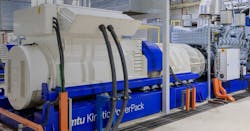Malaysian Semiconductor Maker Secures Critical Power with Rolls-Royce mtu Powerpacks On-Site
Rolls-Royce has commissioned four mtu Kinetic PowerPack engine sets to provide critical and uninterruptible power for a specialty semiconductor manufacturing plant in Malaysia.
X-FAB Sarawak, the Malaysian division of worldwide foundry group X-FAB, will utilize the four mtu Kinetic Powerpacks at its site in Kuching, Sarawak, Malaysia. The company manufactures semiconductor wafers for automotive, industrial and medical applications.
The mtu units feature medium voltage, parallel system configuration at 1,600 kW. The compact Kinetic PowerPacks replace four older dynamic uninterruptible power supply (DUPS) units from a different brand which were starting to drop critical load from the mains.
The mtu Kinetic PowerPacks use a heavy, rotating electromagnetic coil to compensate for short-term current and voltage fluctuations in the power grid.
“Our project team upheld X-FAB’s strong safety culture, product quality and user-friendly equipment during the entire process,” Elvenrey Rios, the project manager for Rolls-Royce Solutions Asia, said in a statement. “The reliable critical load support by the current mtu Kinetic PowerPacks has also resulted in the customer engaging Rolls-Royce for an additional unit.”
X-FAB’s Kuching plant processes about 30,000 eight-inch-equivalent wafer starts per month, according to the company details. The facility also employs more than 1,400 people.
Rolls-Royce is involved at Microgrid Knowledge Conference 2024 in several content sessions
Join us April 22-24 to experience all of the Microgrid Revolution in Energy
The data industry is expanding exponentially, outpacing energy capacity growth in the traditional power grid. Large fab facilities can use as much as 100 MWh of electricity per hour, according to a 2021 blog from Schneider Electric.
Semiconductors are created out of raw materials ranging from silicon, germanium, gallium arsenide or other compounds. The process creating a high-value semiconductor from raw material to completion can often take close to three months, according to reports.
Germany-based Rolls-Royce last year approved its mtu Kinetic Powerpacks for use with renewable diesel such as hydrogenated vegetable oil and other synthetic diesel fuels. The units are based on the mtu Series 4000 and 1600 diesel engines.
Ten years ago, Rolls-Royce fully acquired the mtu brand, several years after taking an initial stake in the business through its joint venture takeover of previous owner Tognum with Daimler. The line of engines was later rebranded under the Rolls-Royce name.








